Is it time to clean out your skincare collection? Here are some tips to get you started.
Spring Cleaning Your Skincare Collection
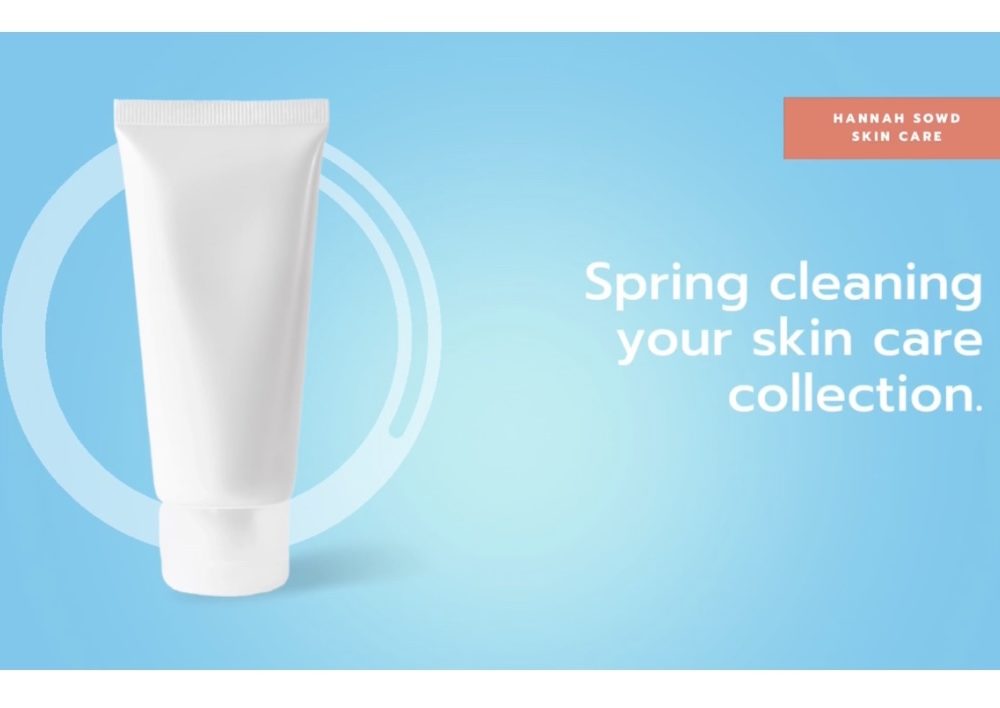

Is it time to clean out your skincare collection? Here are some tips to get you started.

Skincare samples are cute and fun, everyone loves getting free samples.
Skincare samples generally hold 2-5 applications of a product. If your skin needs exfoliation sometimes a product can deliver “wow” results from a single application but using most products a handful of times will not determine the longterm results.
The best way to determine if a product will work for your skin is using it on a regular basis for 30-60 days or two full skin cell cycles.
Samples are a great way to experience the texture and scent of a product. They are wonderful if you have allergies or if you prefer a certain sensation in your skincare routine.
When a moisturizer feels too heavy or light, a cleanser too rich or foamy, we may form a mental block when it comes to our skincare routine.
Your skincare routine should make you happy!
Don’t force yourself to use a product because you think it’s “good for you” if you don’t like the way it feels. The skincare market is saturated with options and sample sizes are a good way to find what will please your senses.
Want a 3 Day Turnaround Kit of product samples created just for you? Have an Online Skin Care Consult with Hannah!
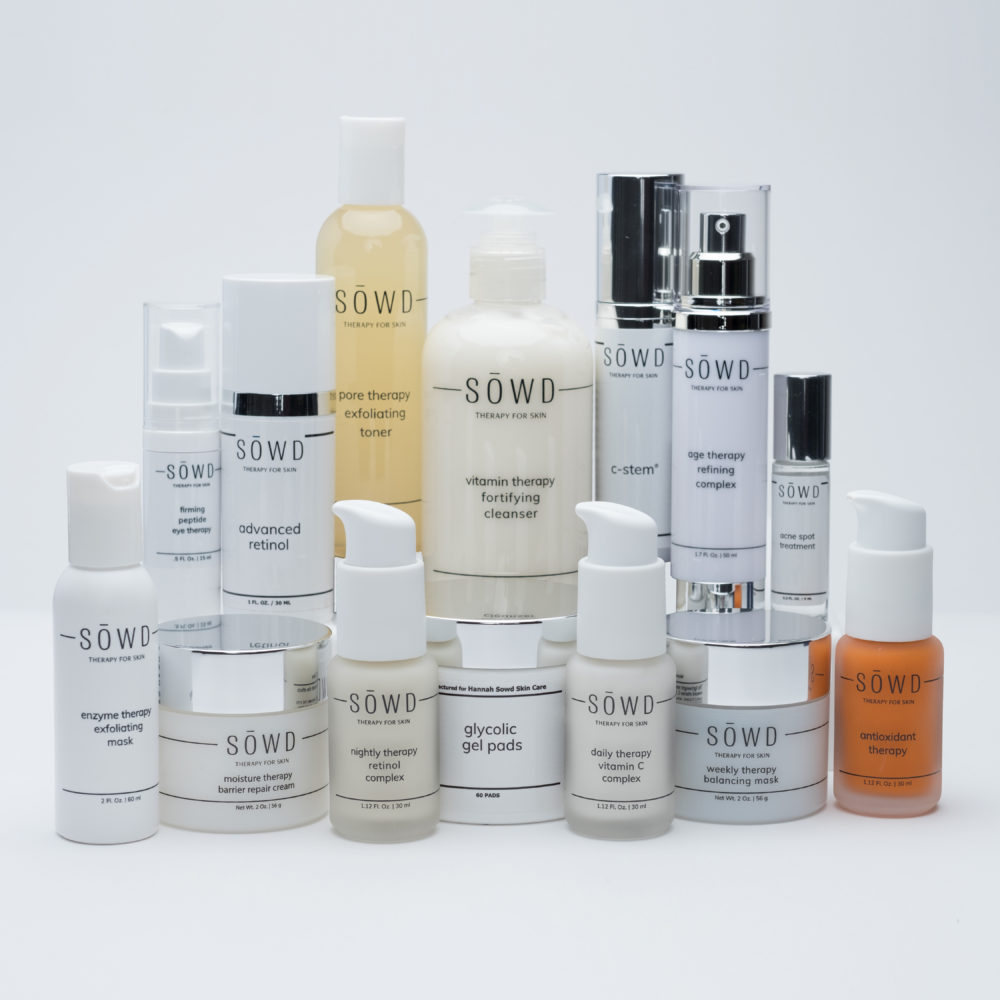
The short answer? You don’t have too.
If a skin care product is formulated correctly, it should work well in a variety of situations.
Any skin care product that is dependent on what comes before or after in the application process should be sold as a kit.
When building your skincare routine, pay attention to the active ingredients in each product instead of the brand.
Your daily routine should include a retinol for evening, a vitamin c serum (or other antioxidant) for day, and a good physical SPF. These can be from the same brand of three different brands that each work well for your skin.
The idea that products need to work as a team was very popular in the 80’s and 90’s, it’s nothing more than a dated sales pitch!

When was the last time you washed your face? Not just a rinse in the shower but a full 2 minute lather with facial cleanser?
Days, weeks, and months blend together during this extended quarantine and sometimes our routines get lost.
Our lives look different now versus 6 months ago; work from home, school from home, PPE in public and at work.
Have you purchased a new bottle of cleanser since the pandemic started? If the answer is no, you’re not washing your face enough.
No matter where you spend your day and what you have on your face, your skin continues to shed cells and produce oil. Regular cleansing is the first step to keeping your skin balanced and healthy.
Wash your face:
Find a cleanser you love. It should leave your skin feeling clean but not dry or tight. If you like the feel of a cleansing brush or other tool, use it once a day in the evening.
Take the opportunity to massage your face for a few minutes while cleansing. Massage stimulates blood flow and lymphatic drainage to increase the health of your skin. Make it a ritual!
Do you have questions about cleansing or your skin care routine in general? Schedule a virtual consult with Hannah.
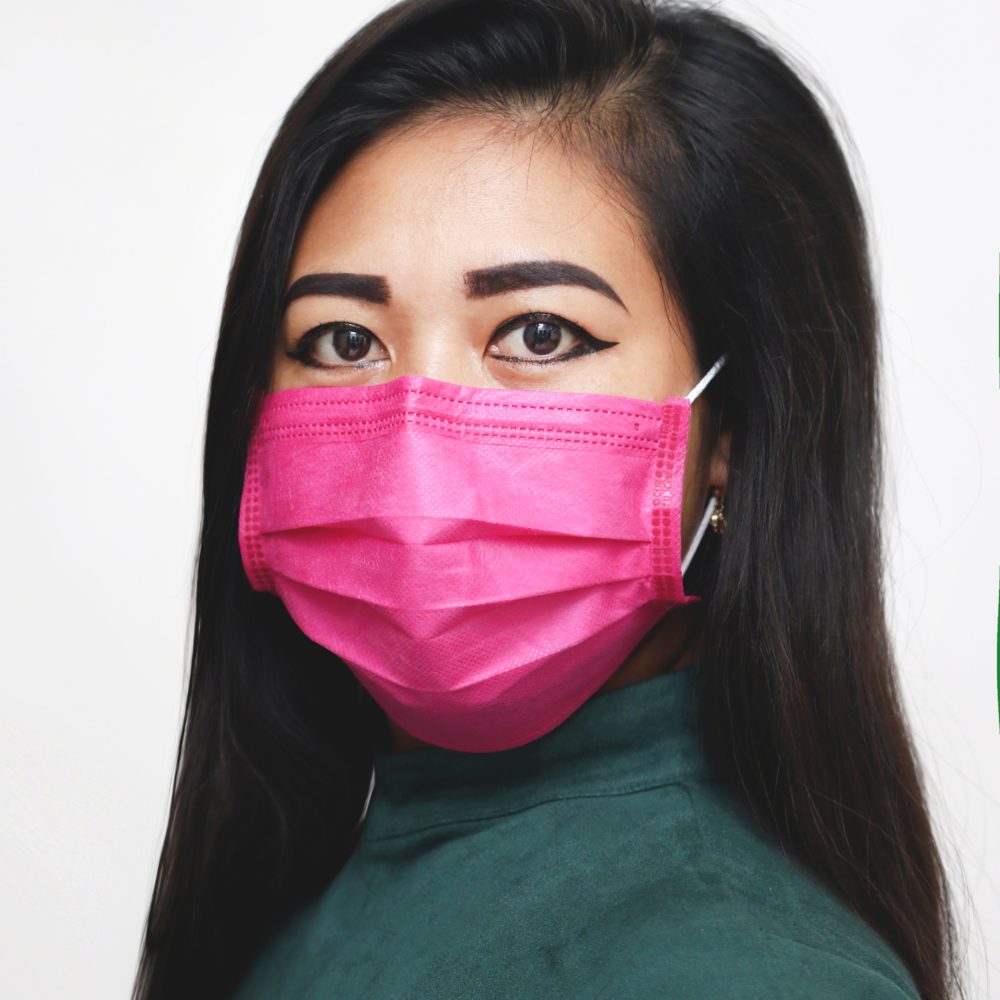
The CDC recommends wearing a face covering in public to prevent the spread of COVID-19 but what about the skin underneath?
Spring is here and outdoor temperatures are rising. My face is sweating more than normal while running errands with a mask and I have a crop of pimples on my chin as a result.
My goal is to keep my skin clear and protect myself (and those around me) so I took a look at my daily skin care routine.
I wash my face morning and night but not when I return from running errands outside (contrary to my own advice). My skin gets dry easily so I added pore therapy exfoliating toner to my routine when I remove my mask instead of a full cleanse.
I swapped my current products for a lighter SPF and day lotion, plus added a spot treatment for my chin. I continued masking on a weekly basis alternating between oil absorbing clay and a hydrating treatment option.
I incorporated a blue LED treatment three times a week to kill the bacteria. This is a good option for spot treating acne at home.
I also washed my mask. At the moment, I rely on one cloth mask with a charcoal filter left over from the California wildfires but I have 2 more on the way. The goal is to rotate 3 masks, keeping them clean on the inside and out.
When I return to work at my studio, I will be wearing a face mask for 8+ hours a day. I plan to keep up the above routine as well as incorporate more exfoliation and hydration.
How has your skin responded to wearing a mask?

You want nice skin but you also care about the planet, how can you balance your concerns?
Several large companies have recently made commitments to cut back on post consumer waste by using recycled plastic, refillable bottles, and less outer packaging. This is a huge step in the right direction!
Some small tips can go a long way when it comes to environmental impact from personal care products:
Looks for items with the least amount of packaging. Excessive wrapping can look pretty and make it feel like you are getting a “gift” but most of it ends up in the landfill.
Shop locally. Not only do you support your neighbors and community, but you lessen the environmental impact of shipping and packing materials.
Use up all the products you have. If a cream is too rich for your face, use it on your body. Don’t throw away perfectly good products!
Streamline your routine to 2-3 products per season. Rotate your products as necessary when a bottle is empty. 5-6 open products run the risk of expiring before you can use them all.
Recycle your empty packages! This may seem obvious but if there’s no recycling bin in the bathroom it’s an easy one to miss.
Donate unused items. Skin care can be an impulse buy and return policies can be strict. Check with your local homeless shelter, many of them welcome donations of unused (or gently used) personal care products.

“When should I start using anti-aging skin care? I want to prevent aging before it happens!”
I hear this from my clients often and the answer is simple, you probably ARE using anti-aging skincare.
Sunscreen is the most important step to maintaining youthful skin and this is a product we should use every day at every age.
Most exfoliants and antioxidants (like retinol and vitamin C) may have been recommended to help with issues like acne and pigmentation but in the long run, also help with signs of aging.
If you are seeing fewer breakouts and more fine lines, check your routine for drying ingredients like benzoyl peroxide and salicylic acid. These are both great to use as spot treatment for the occasional pimple but not in a cleanser or cream since their job is to absorb oil.
Check your moisturizer, do you need a heavier product? You may want to consider layering a serum and a mid-weight lotion to get the power of anti-aging actives without clogging your pores.
Ingredients like hyaluronic acid provide intense moisture without being heavy.
Leave the super heavy creams for your grandma (or your ski vacation). Your face doesn’t need to feel like an oil slick to keep wrinkles at bay.
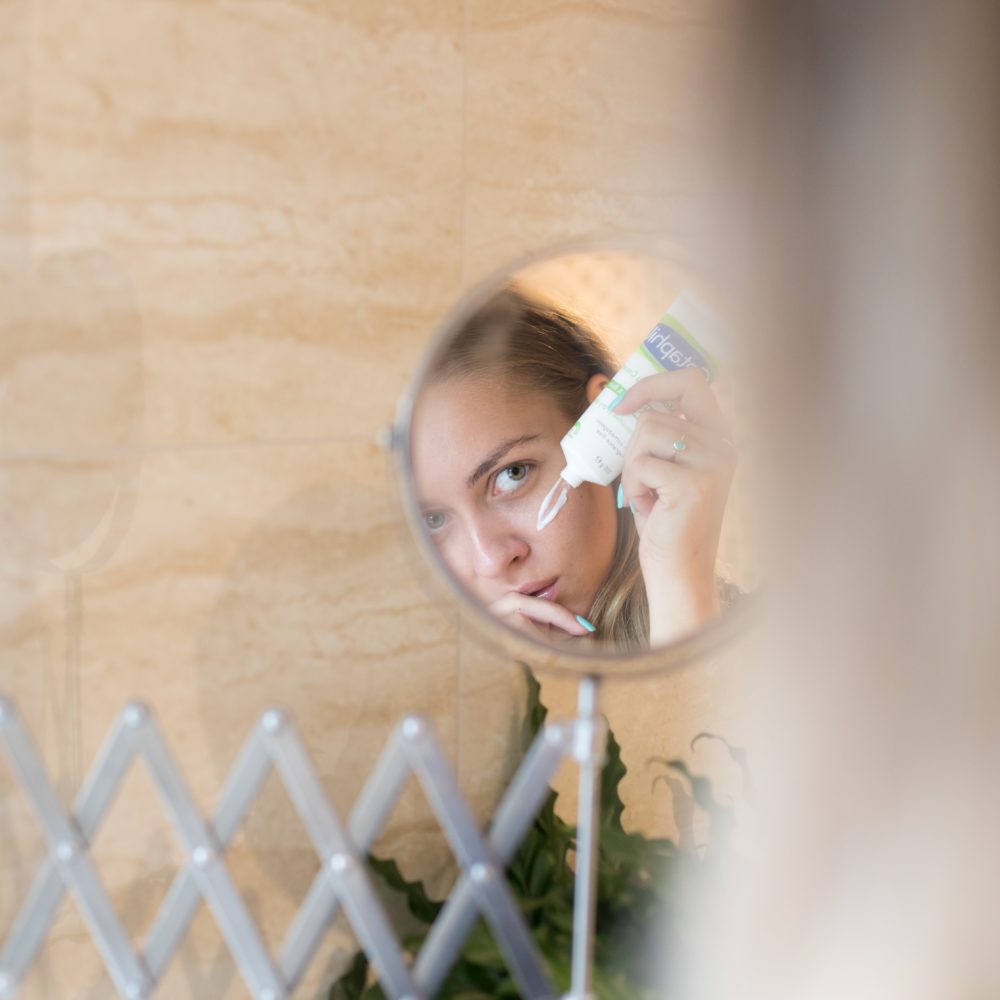
There’s no question, zinc oxide and titanium dioxide provide the best protection for your skin and are healthiest for the environment.
Sunscreen products that contain these ingredients are usually labeled “mineral” or “physical”. Check the active ingredient list on the back of the label, it will contain zinc or titanium (or both).
Here are a few tips for applying physical SPF:
Apply physical SPF on clean skin or over a serum only. Layering too many products can feel uncomfortable. If you need extra moisture, consider an SPF with moisturizer.
Use a nickel sized dollop of SPF to cover your entire face. The length of the top portion of your pinky finger is about the correct amount.
Apply the product to your hands, rub them together to warm the product then spread it all over your face, neck and ears. Use outward feathering strokes to blend it in. Do not dab the product on the face like concealer then attempt to blend it in.
Wait 2-3 minutes after applying. Brush your teeth. Do your hair. Some physical SPF products appear a little white initially but then it disappears.

The skin from your jawline to your collarbone is exposed to the elements for hours every day. Do you include it in your skin care routine?
What is the best way to care for this delicate area?
The skin on the neck and chest has fewer oil glands than the skin on the face which makes it more sensitive. When considering products for this area, focus on hydration and protection.
Cleanse the area with a nourishing cream cleanser. Follow with a hydrating cream with calming ingredients. Focus on anti-aging formulas with ingredients like peptides, niacinamide, and hyaluronic acid.
Do a patch test before using products that contain retinol or glycolic acid on your neck. If your skin responds well, use them 1-2 times per week but follow with a hydrating cream.
Use a physical SPF every day regardless of exposure and time of year. I apply my SPF to my face, neck, and chest before getting dressed ensure maximum coverage.
Professional treatments like chemical peels and microdermabrasion are a great way to treat fine lines and pigmentation on the chest and neck. More intense treatments like Ultherapy are required to treat skin laxity in this area.
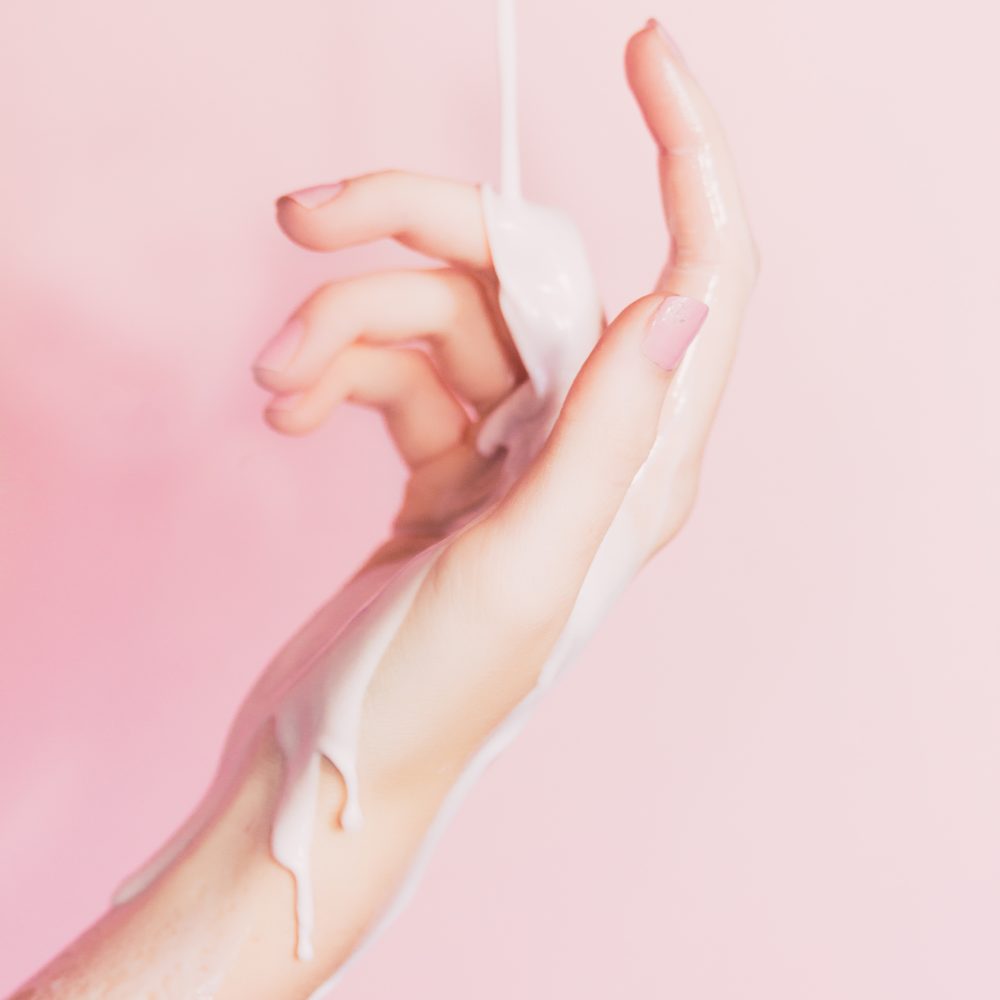
You’ve found skin care products that work for your skin but are you using them correctly?
Consider the following for each product in your skin care routine:

How often you swap out your skin care products depends on several factors, mainly the environment and your skin type.
If your city has four distinct seasons, you need two sets of products to get thru the year. A gel cleanser and light serum will control oil on warm and humid days but a cream cleanser and more moisture will be necessary during cold and windy months.
If you spend the majority of your time in a steady climate, you can have one routine for the entire year. So when should we try something new?
There is a common myth that skin gets used to a product and it stops working as well.
Your skin will not build up tolerance to a topical product. You shed the top layer of skin every 28-35 days, the product is interacting with “new” skin on a regular basis.
When we start using a new product, we see the most visible results in the first 30-90 days. Then the results plateau but the product is still doing its job. If you stopped using the product and your old skin conditions returned, you would realize how well it was working.
If you feel like your routine isn’t working as well as it used to or you are developing new skin issues, schedule a consult with a professional.
Most people need an entire range of new skincare products at least once per decade. Your routine from college isn’t going to serve you very well in your 30’s!

Way back in high school, I bought a deodorant crystal because they were trendy. I faithfully dampened that rock and rubbed it under my arms yet I still smelled funky at the end of the day. I quickly returned to my stick of Secret and haven’t looked back since.
Working in close proximity to clients all day, having body odor is not an option. I need deodorant that works well for a long period of time!
My job involves reading a lot about personal care ingredients and how they interact with our bodies. A study showed a possible link between the aluminum in anti-perspirant and Alzheimers. Then a study disproved the link between anti-perspirant and Alzheimer’s.
It’s difficult to know what to believe but many people are opting for an aluminum-free deodorant just in case.
After 30+ years of relying on anti-perspirant, I noticed it wasn’t working as well for me. Being a skin nerd, I did come digging. Over time, sweat glands begin to rely on the product and stop producing odor killing bacteria. Anti-perspirant was affecting my skin microbiome!
I decided to see if I could find a “natural” product that worked well enough for me to use during a workout or a work day. The body needs an adjustment period of 2-3 weeks when switching to from an anti-perspirant to a deodorant. It all made sense, during this time the odor killing bacteria would begin to flourish again.
Anti-perspirant controls odor and wetness. It contains aluminum particles to block the sweat glands and keep you dry. The controversy is over whether these particles absorb into the body or stay put on the surface of the skin until you wash them off. Some “all natural” brands make anti-perspirants; these still contain aluminum. One lists it as “recycled aluminum”, no joke!
Deodorant controls odor but not wetness. Most “natural” brands use ingredients like baking soda, coconut oil, shea butter, and essential oils.
Always read the ingredient panel, the statement “all natural” does not require any approval.
For the sake of my clients, I experimented on my days off. It was easy to try a new deodorant during a morning workout; if I wasn’t offensive by the time I got home I knew I was on to something!
It took some trial and error, one product left me smelling like rancid baking soda and I learned I am really partial to deodorant in a stick form, not a cream or spray. I found a natural deodorant with no aluminum that I like, I’d give it a solid 7/10.
I switch between the natural deodorant and my old anti-perspirant depending on my schedule for the day. My anti-perspirant works better since I use it less often and I’ve let my natural bacteria flourish. If I have a long workday plus an event after, I don’t need to reapply. On shorter days, I’ll opt for the deodorant.
Non-aluminum deodorant brands are everywhere right now. If you’re considering making the switch, give your body time to adjust. Introduce the new product gradually during times when you won’t be embarrassed if you end up with a little body odor.

The end of summer is close, it’s been fun but your skin isn’t looking or feeling it’s best.
Even if you have oily skin, you’re probably dehydrated. Travel, alcohol, and warm weather all suck precious moisture from our skin.
This is the one time of year you don’t have to be acne prone to have clogged pores. All of the above plus extra sunscreen will make sure of that.
Now is a great time to have a deep cleansing and hydrating facial. Treatments like microdermabrasion and LED light therapy are perfect for End-Of-Summer-Skin. Hold off on deeper chemical peels and hydroquinone-based lightening products until after Labor Day.
If the heat has triggered your melasma, now is a great time to start using a hydroquinone-free lightening product. These products will start to gently even your skin tone without photo-sensitivity. Save the stronger products and treatments for the fall and winter months.
Your home care routine should include a gentle enzyme exfoliation 1-3 times a week (depending on your skin type) followed by a hydrating mask.
Antioxidant serum and physical sunscreen are important year round. If you live in a humid climate, you may want to swap these products for lighter versions during the warmer months.
Do you have questions about your skin and what products you should be using? Have an Online Skin Care Consult with Hannah!

As a new mother, the best skin care routine can be the last thing on your mind. Feeding your baby and getting enough sleep take priority!
When life gets busy for any reason, products that do double (or triple) duty are key.
While breast feeding, continue to avoid all the topical ingredients you steered clear of during your pregnancy.
It is not uncommon for a new batch of hormonal acne to crop up after giving birth. Your skin may also be sensitive during this time so find gentle products that balance oil production.
During the first few weeks (or months), keep it simple. Cleanse your face twice a day, use an SPF moisturizer during the day and a simple moisturizer at night. Set a realistic goal for yourself and build up to your old routine when you have more time and energy.
I love vitamin therapy: fortifying cleanser for most skin types. It removes makeup (including eye makeup) and rinses clean. The cream formula is gentle yet it won’t clog pores.
Suntergrity Natural Moisturizing Face Sunscreen is my favorite all in one daytime moisturizer plus SPF. It has antioxidants and zinc oxide which help prevent pregnancy related melasma from getting worse. There is a tinted version if you like a little color.
After cleansing at night, I recommend a simple hydrating cream to calm the skin that won’t clog the pores. moisture therapy: calming repair cream is good for most skin types and can be layered with a serum if you have more time.
Once your baby is sleeping thru the night and you have more than 60 seconds for skin care, add a vitamin C serum and exfoliate 1-2 times a week with glycolic acid. These products with begin to diminish any lingering discoloration from melasma or acne and brighten the skin.
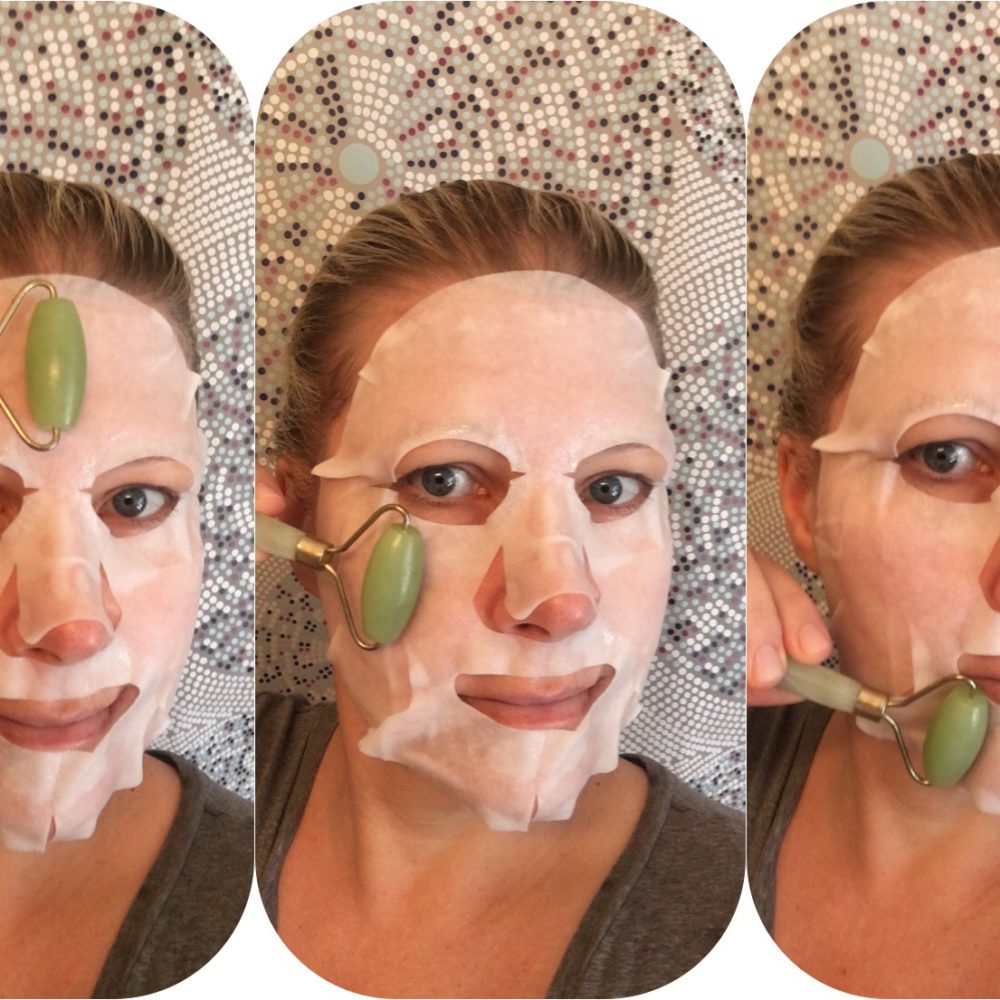
I love it when I find a simple skin care tool that delivers real results. Currently, my jade roller is that tool!
You can use it over a sheet mask for extra product penetration or with your favorite serum for a face massage. It’s a fun addition to my daily routine, my face instantly feels less puffy and smoother.
A general rule of thumb for facial massage is move up from the jawbone and away from the center of the face.
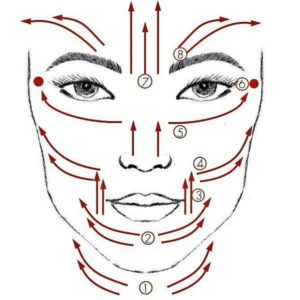
I do four passes with my jade roller on each of the areas above. Once you get the hang of it, you can complete your entire face in a few minutes.
What’s your favorite way to use your jade roller?
Do you have questions about your skin and what products you should be using? Have an Online Skin Care Consult with Hannah!

Melasma is a very common concern among the clients I see in my studio.
Often called “the mask of pregnancy”, the discolored patches of skin are triggered by hormonal activity and sunlight.
The first step in any treatment plan is to determine what triggers your skin discoloration.
If hormonal fluctuations cause the discoloration, it is considered melasma.
If the discoloration is from acne inflammation, it is considered hyper-pigmentation. A treatment plan for hyper-pigmentation will include products and treatments to keep the acne under control, as well as treat the pigment left behind.
Adequate, daily, sun protection is a part of the treatment plan for discoloration. The sun is a trigger for any melanin disorder, regardless of the trigger. SPF with a physical ingredient is more effective at controlling pigment than SPF with a chemical ingredient.
Treating melasma is a two step process. First, remove the existing pigmented skin and second, prevent new pigment from forming.
Melasma pigment is removed with varying degrees of exfoliation using microdermabrasion, chemical peels or lasers. The best treatment for you depends on your skin tone, your lifestyle, the amount of downtime you are comfortable with, and the amount of money you are willing to spend.
Melasma is controlled with religious sunscreen application, regular exfoliation, topical vitamin c and a rotation of hydroquinone and botanical skin lightening creams. A consult with a skin care professional will determine the best routine for your skin and your lifestyle.
Lifestyle is an important consideration for melasma treatments. You can erase all the pigment spots you currently have only to see them return after an hour unprotected in the sun. If you spend a lot of time outdoors, please consider a more moderate approach.
Do you have questions about your skin and what products you should be using? Have an Online Skin Care Consult with Hannah!

What is melasma? How is it different from hyper-pigmentation or freckles?
Melasma is a dark patch of skin, usually triggered by hormones and sun exposure. Hyper-pigmentation is a dark patch of skin, usually triggered by inflammation (such as acne) and sun exposure. Freckles are dark patches on the skin, often present since birth but they get darker with sun exposure.
The one common denominator? SUN EXPOSURE! Any unusual melanin activity is made worse by excessive, unprotected sun exposure.
The first step to treating discoloration and preventing new discoloration, no matter what the cause, is adequate sun protection.
The next step is to determine the root cause. Are you using hormonal birth control? Is the hyper-pigmentation showing up in areas where you previously has acne? This helps determine what treatment products are best for you.
Melasma triggered by pregnancy or birth control will usually begin to fade on its own 3-6 months after hormone levels have returned to normal.
Hyper-pigmentation from inflammation can take a few weeks to a few months to fade, depending on the melanin content of the skin.
A comprehensive routine of home care and professional treatments is the best way to treat both melasma and hyper-pigmentation.
Do you have questions about your skin and what products you should be using? Have an Online Skin Care Consult with Hannah!

Skin care gadgets are popping up everywhere, but do they work?
Derma-rollers, skin tightening devices, and LED masks; you can purchase many devices to treat yourself in the comfort of your home but how do they compare to professional treatments?
Any device approved for sale to the public isn’t going to be as powerful as the professional version. Yes, even the ones sold on Amazon labeled “professional”. To obtain a professional machine, you must show the manufacturer your license and receive proper training.
Instructions on most home-use devices will tell you daily use is required to see results. This is important. Ask yourself “Will I devote 15 minutes every day to this machine?” before making the investment.
It’s better to spend your hard-earned money on a few professional treatments instead of a closet full of expensive gadgets you don’t use!
Home-use devices like facial cleansing brushes, skin tightening devices and LED masks can be beneficial if you use them properly (and daily!).
Avoid home-use microdermabrasion machines and microneedling. When you pierce the surface of the skin, there is a risk of scarring and infection. These are treatments best left to the professionals.
Do you have questions about your skin and what products you should be using? Have an Online Skin Care Consult with Hannah!

Anti-pollution skin care is a trending but what does it mean?
Environmental pollution at an all time high; how does it affect your skin?
No matter where you live, air and water quality are getting worse and a weakened ozone layer has strengthened the intensity of the sun.
How does skin care protect you from environmental pollution?
Proper cleansing and hydration of the skin is the first step.
The skin is one of your largest organs and it’s primary function is protection.
Clean, hydrated skin functions at an optimal level to protect your system from pollution. Dehydrated skin has a compromised barrier so it becomes more susceptible to damage from environmental pollution.
Antioxidants like green tea and vitamin c help fight free radical damage from environmental pollution.
SPF with a physical ingredient like zinc or titanium dioxide helps provide an invisible barrier between your skin and the environment. These ingredients provide the best protection from the sun as well.
Use a cleanser that removes your makeup, sunscreen, and the traces of dirt from your day. When clients tell me they don’t wash their face at night because they don’t wear makeup, I tell them to run their finger across the window of their car after driving around all day. All the same particles end up on your face!
The combination of an antioxidant serum and a physical sunblock will provide the best protection from the elements on a daily basis. Save the heavy, anti-aging creams for nighttime when your skin is in repair mode.
Do you have questions about your skin and what products you should be using? Have an Online Skin Care Consult with Hannah!

A natural charcoal water filter in a glass carafe is my new favorite way to purify my drinking water. Always on the lookout for ways to reduce the amount of plastic I use in daily life, natural charcoal is the perfect solution.
Kishu Binchotan Charcoal Sticks are made from 100% Ubame Oak branches burned in a specialized kiln at extremely high temperatures. The process is called “nerashi”; it carbonizes the structure of the wood and leaves behind countless porous cavities for water to fill.
When new, the charcoal sticks are so smooth they feel almost like glass. Each stick must be prepped with boiling water then rinsed with clean water before added to your water carafe. This activates the charcoal and removes any remaining ash or loose bits.
The charcoal should be boiled every 3-4 weeks to release the buildup of impurities it has absorbed from the water. Replace the charcoal after 3 months of use.
When your charcoal is no longer effective for water filtration, it can be recycled. Break the used sticks into smaller pieces and add to your garden or houseplant soil. The recycled charcoal will aerate your soil and increase microbial activity.
No waste + clean water!